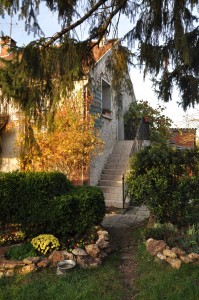The change in terrain is almost overwhelming. Gone are those rolling hills of Lorraine and the flat expanse of the Pas-de-Calais. Here the Grand Morin winds through a deep valley, a location appreciated by neolithic tribes in the millennia BCE, centuries of farmers and tanners, and paysagistes like Camille Corot in the 19th century.
Our hilltop gîte Milleroses in a village that is part of Crécy-la-Chapelle is reached only by zigzagging lanes clogged by parked cars. It is a strange mix of city, suburban and semirural. On our first night we dodged out to find an ATM machine; on the way back, while resting at a stoplight at our turn onto the main drag, my eyes wandered into a patch of gray-brown woods about halfway up the hillside on the opposite side of the road. Movement! A doe! I have seen countless signs covering countless kilometers of French countryside alerting motorists to wildlife, but I have to get into a commuter community of Paris before I actually see a deer.
Our search for an ATM (BNP Paribas only as it is a partner to Bank of American and therefore doesn’t charge a fee) took us into the Ville Neuve of Bailly-Romainvilliers. A planned community, it reminded us of the Rouse-designed town of Columbia, Maryland. There was a mix of housing, lots of apartments above the shops in the village center-shopping center and fully detached homes with small garages fronting winding streets that included cobbled pedestrian walkways and postage-stamp sized greens. It had a Mairie and two or three schools, a church, sports fields, an indoor pool, and a cultural center that was quite something. Due to a snag in Internet access at Milleroses, I wondered if so modern a town might not have a nice, new library where one could grab a little Wi-Fi time; indeed they do. The Cultural Center includes a médiathèque or media center, the new name for the old bibliothèque. The médiathèque was closed but a sign on the glass wall provided hours of operation and the announcement that since March of 2010 the libraries of the region provided free Wi-Fi to residents and, with a password provided by librarians, to visitors as well.
I can imagine wails of indignation that this all looks like the Disneyfication of French town life—and in fact Disneyland-Paris is but a short distance away—but it struck us as something rather appealing. A huge number of residences appear to be within walking distance of the shops, offices, medical facilities, drycleaners, and other businesses clustered in mall-like fashion at the center and dedicated bike lanes and piétons make it safe for kids, especially. There is a lot to do, a lot of ways to be social and active. Okay, the croissant I bought at the boulangerie wasn’t that great but the bread was decent and the little tarte de pomme genuinely good. Anyway, you can be in the most authentic French locale you can fantasize and still not get a good croissant. Major highways head toward the four points of the compass. The central train station in Crécy runs trains to the Gare de l’Est and back about once an hour from just after five in the morning to some extremely late hour at night, so all the resources of the City of Light are conveniently close.
In the end, the appearance of the residents, the makes and models of the cars, all suggest that Bailly-Romainvilliers is a working-class to middle-class community, not a suburban enclave for the wealthy. It looks like a town where you can raise children, work, and retire. Pretty darn nice.

